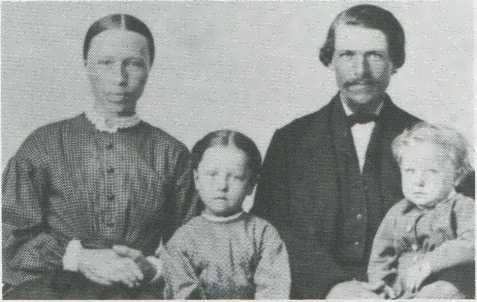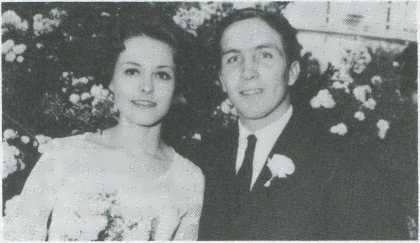an English Quaker “evangelist" and was soon converted. He adhered to the “inner light" and perspective of the Quaker tradition until his death at the age of 97.
Being brought up as a Quaker girl had its trials as well as its bright side. One concerned clothes: quaker girls wore brown, black, or olive-drab dresses. At the time of the Decorah interlude a prevailing style among the “other" young girls prescribed frilly, lacy white dresses, especially for church. Lese agitated constantly for a white dress but was ignored. Finally one Sunday she counted the number of young Lutheran girls marching up to Sunday School who wore white dresses (the Walds lived in the third house from the corner on the north side of the westernmost block of West Main Street in a house which was still extant in 1995). That noon at dinner Lese remarked casually but meaningfully, “I counted forty-seven girls in white dresses this morning.” Her father cleared his throat, looked at her with a most penetrating stare, and said gruffly, “We’ll hear no more about white dresses!” That ended the matter.

Left to right: Tonetta Wald, Lese Walk (Field), John Wald and Louis Wald, circa 1870-72
In the early 1870's John Wald (who worked in a shoe shop in an old brick building in downtown Decorah which was torn down for a parking lot in the 1980's) moved his family to Forest City, where he farmed. There as a young girl Lese met Julius Field the man who would become her husband years later. He was her Sunday School teacher. From Forest City the Walds moved to LeGrand, a small Quaker village in central Iowa where Lese met her best childhood friend, Caroline Gimre (later Mrs. Meltvedt). Their friendship was lifelong until Lese’s death at age 90. Lese also had a younger sister, Emma.

Elizabeth and James Hogan III
Later the Walds moved to Almena, Norton Co., KS. Shortly before her marriage (in 1882) on the occasion of one of Julius Field’s visits from Iowa to court her, she related how she and Julius rode horseback over the prairies. Although usually not much inclined towards the use of firearms on this occasion the groom-to-be carried a revolver and shot skulls as targets.
Lese Wald and Julius spent their marriage on the Field family homestead in Forest City, IA where they raised nine children, including Henry Paul Field, who would one day come to spend his adult life as a dentist in Decorah.
All her life Lese was known as a peacemaker, someone who had a remarkable ability to placate and “get along” with people, bringing out the best in them. Her daughter-in-law Iduna Field, a long-time Decorah resident, loved Lese as a mother and named her daughter (Elizabeth Wald Field) after her. Lese Wald Field was also a woman ahead of her time as she taught country school for a full year after the birth of her first child in 1883 riding home over lunch hour to nurse the baby.
A coincidental postscript to Lese Wald Field's childhood sojourn in Decorah concerns the family’s Irish neighbors named Hogan. Although not of the same faith, the Hogans were apparently so fond of the children that they gave Lese fruit and candy and baby brother Louis a rosary when the Quaker Walds departed from Decorah in 1871 or 1872. Almost a hundred years later, in 1965, Lese’s grand-daughter and namesake, Elizabeth Wald Field (Dr. Henry Field’s daughter) and James John Hogan III, a grandson of Patrick Hogan, one of the children of the Wald's neighbors, were wed in Ankara, Turkey, where the groom served in the Peace Corps.
Lese Wald Field died in Forest City, IA 4 Feb 1953.
Finholt, Martin and Pauline (Nygaard)
(Kathy Finholt Arbogast)
Martin Andreassen Finholt was born 10 Aug 1854 in Aurskog, Akershus, Norway. He was raised on the Finholt farm in the Aurskog area where his parents, Andreas Harraldsen Finholt and Maren Oline Andersdtr Myrvold, were husman (cottagers) with a small farm plot of their own on the Prestegarde (Parish land). Martin had twelve brothers and sisters: Anne Marie, Tea, Johan, Anders, Edvard, Kasper (died 1868), Maren Bolette, Karen, Helena, Mathea (died 1879), Kasper, and Inga Oline. They all attended the little Aurskog school where Ole Hohle was the teacher and minister’s assistant.
On 29 Dec 1878 Martin married Pauline Olesdtr Nygaard who was born in Christiania, Norway, 15 Mar 1857. Her father is thought to have been the lensmann (sheriff) for the area of Aurskog.
Martin’s older brother, Anders, would be Neste bruker and inherit the small plot of land and position on the Prestegarde. This meant the younger brothers and sisters would have to find other places to make their living. Martin and some of his brothers and sisters and their families decided to leave Norway for America where they would have a chance to make a better life for themselves and their future families.
F-12
Complete OCR transcription.
See the associated scan to compare with the published information.


